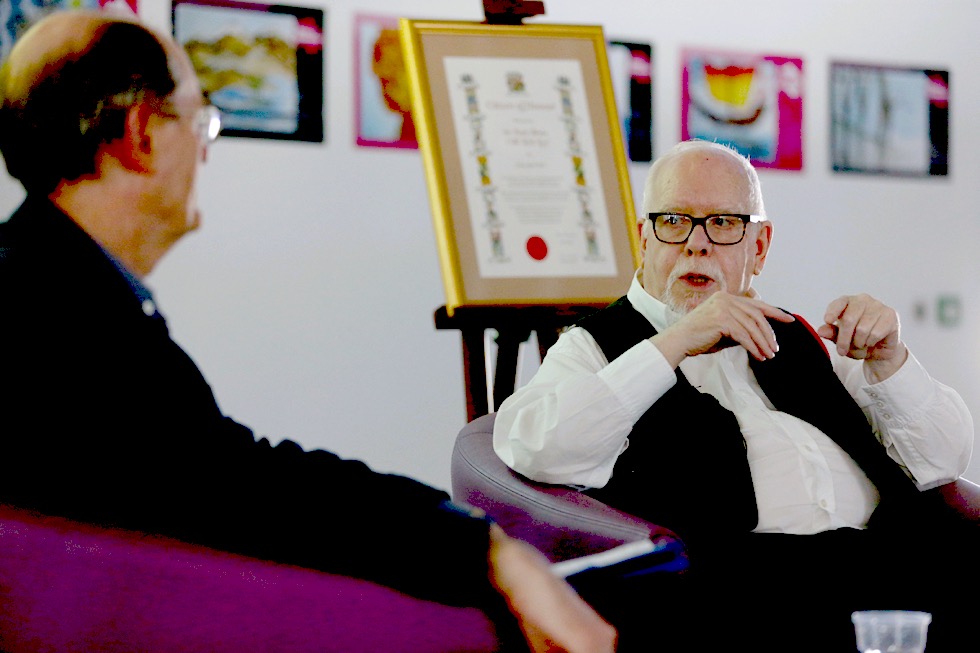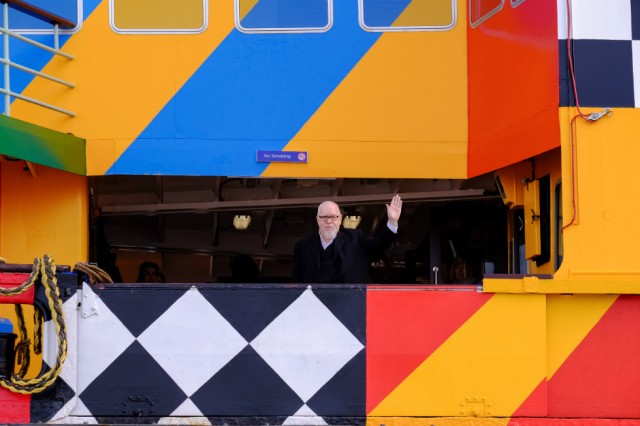“I haven’t been taken seriously as a painter…” In Conversation: Sir Peter Blake

Interviewed by his nemesis, confessing insecurities, and returning to THOSE fairy paintings: Denise Courcoux sees an alternative side to the Godfather of Pop Art as he is appointed Citizen of Honour in Liverpool…
“I haven’t been taken seriously as a painter; as seriously as some others have.” It comes across as touching, rather than gripey, to hear a man who’s just spent an hour reflecting on the highlights of an artistic career spanning 60 years confess his insecurities. Sir Peter Blake’s interviewer, art historian and curator Richard Cork, is likely someone who has contributed to this self-doubt; the pair had a bitter public spat in the letter pages of The Guardian after Cork’s critical review of the 1977 Hayward Annual, featuring work by Blake. Blake’s allusion to their old animosity adds frisson to a cordial in-conversation; you can’t help but wonder what’s bubbling under the surface some 40 years on.
Blake is at the Museum of Liverpool on the occasion of being appointed a Citizen of Honour in Liverpool. It’s a fitting accolade given his close relationship with the city over the years; from winning the John Moores junior painting prize in 1961, to his retrospective at Tate Liverpool in 2007, to his razzle-dazzled ferry for the 2016 Liverpool Biennial – which it has just been announced will be a bright speck on the Mersey for a further two years. Not to mention a certain album cover for four “jolly little chaps”. At nearly 85, Blake has been in his self-defined “late period” for 10 years already, with no plans for retirement. He cheerfully proclaims it his opportunity to go “a bit barmy” in the manner of Picasso or De Chirico, and afford himself the right to do whatever takes his fancy.
The interviewer beckons Blake back to the very beginnings of his artistic career. An early childhood of the evacuations and rations of World War II meant art entered his life at the age of 13, when he enrolled in art school at Gravesend Technical College. He went on to study at the Royal College of Art in the mid-’50s, where after a first year of intensive life drawing he was “let loose” as a painter. Popular culture was a major influence from the start. Blake describes drawing on experiences from his working class upbringing in Dartford: wrestling and fairgrounds, music hall and jazz clubs. He has been referred to as the Godfather of Pop Art, but Blake takes a broad view of the movement as a transatlantic force – with Jasper Johns and Robert Rauschenberg in the US, and in the UK Richard Hamilton, Eduardo Paolozzi and himself all there at the beginning. He describes the particular impact of Kurt Schwitters’ collage works on his own practice; Blake would go on to curate a Schwitters-inspired exhibition, About Collage, at Tate Liverpool in 2000.

Cork is disarmingly enthusiastic as he coaxes an anecdote from a self-deprecating Blake about his lunch with Marlon Brando (“he was very grumpy, he didn’t want to be there!”). The audience, too, are keen to hear about his brushes with 20th century pop culture greats, asking about his student Ian Dury and a reticent Andy Warhol (“most of our meetings were monosyllabic”). It’s a stellar cast of characters, much like those gracing Blake’s most famous creation: the cover design for those aforementioned jolly little chaps The Beatles’ Sgt. Pepper’s Lonely Hearts Club Band. It’s such a ubiquitous image that it’s easy to disregard what an undertaking the project was. Cork describes it as a “monumental sculpture”: an assemblage of life-size cutouts and waxworks from Madame Tussauds. Blake considers he made it much more complicated than was necessary; a reflection probably influenced by his meagre payment of £200 after his dealer signed away the copyright to it. “It’s a sore point that died away, but it’s all come back recently”, Blake half-jokes, as it currently celebrates its golden anniversary year.
As the 1960s drew to a close Blake was “exhausted” by London, and moved to the West Country. His worked changed direction dramatically during the ’70s; it’s this period that drew Cork’s contemporary criticism. Blake’s pop cultural subject matter gave way to an unexpectedly sentimental approach, including watercolour illustrations for Alice in Wonderland, and Richard Dadd-inspired fairy paintings. We learn that Blake has been revisiting some of his old half-finished fairies of late, transforming them into tattooed ladies; a mirror of the tension between urban and rural in his career. Despite the insecurity about critical validation, Blake considers his an “extraordinary life”, and cites one of his own heroes in summing up: “I’ve done an album cover for Brian Wilson. I think I’ve achieved every ambition… I’ve been very lucky.”
Denise Courcoux
Denise saw Sir Peter Blake and Richard Cork in conversation at the Museum of Liverpool, 23 April 2017 — a Liverpool Biennial event delivered in partnership with Museum of Liverpool, with support from Hard Days Night Hotel
From 25 May to 16 June 2017, Liverpool celebrates The Beatles’ Sgt Pepper’s Lonely Hearts Club Band, the most influential album ever made – on the 50th anniversary of its release on 1 June 1967 during the Summer of Love. See the full programme of city-wide events here, in addition to BBC programming here
Images, from top: Sir Peter Blake and Richard Cork in conversation, courtesy Dave Thompson / PA Wire. Sir Peter Blake’s Dazzle Ferry, courtesy Mark McNulty





